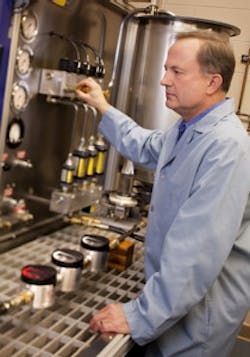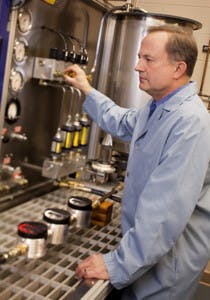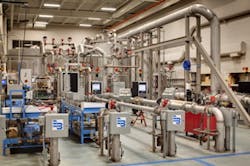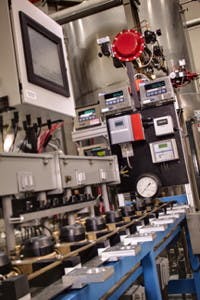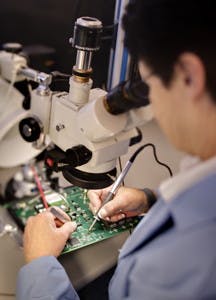World-Class Innovation Center Stimulates Flow Measurement Technology Advancements
As one of our most precious commodities, water represents important income potential for municipalities. If its use is not accurately measured, customers may be under- or over-charged for consumption. For most utilities, revenue loss due to inaccurate metering is a significant issue. According to a recent study by the American Water Works Association (AWWA), the loss of revenue attributable to apparent losses accounts for between 0.5 percent and 5 percent of a utility's total revenue1. Apparent losses may be caused by faulty, improperly sized or misread meters or by using an incorrect type of meter for the system and environment.
Using an advanced research and development facility in the heart of the company's Milwaukee, WI, headquarters, Badger Meter engineers and technologists design, create, refine, and perfect flow measurement products for both the water and industrial markets. Past the reception area, offices and meeting rooms, visitors are welcomed into the 50,000-square-foot James O. Wright Innovation Center. Named in honor of the former chairman and CEO who served the company between 1946 and 2000, it is the only private cold water testing facility of its kind.
A History Steeped in Innovation and Dependability
Badger Meter introduced the first frost-proof meters in 1905 and has been a leader and innovator in flow measurement solutions ever since. The company's commitment to producing high-quality, accurate flow measurement products led it to design and build the James O. Wright Innovation Center in 1999.
"This facility was specifically designed to allow us to run comprehensive tests on our products and make improvements to ensure their safe and accurate performance," said Ron Benson, mechanical engineering manager at Badger Meter and one of the original team members tasked with developing the center. "It helps us understand the lifetime performance of products in the field and demonstrates our promise to provide top-performing metering equipment to our customers."
Model Shop
The product development process begins with product design using Advanced Computer-Aided Design (CAD) systems. Prototypes are then built in the model shop, which includes Computer Numerical Control (CNC) machines that automate the process. Once created, the prototypes undergo evaluation and an exhaustive testing process.
Hydro Lab
The largest testing area -- and focal point of the innovation center -- is the Hydro Lab. Twenty-one stainless steel tanks with capacities between 12 and 12,000 gallons dot the 12,800-square-foot area. Underneath the concrete floor is a reservoir that holds up to 125,000 gallons of potable water. Pumping systems, pressure tanks and a weir tower enable engineers to effectively replicate the water sources found in residential, commercial and industrial applications.
There are nine areas and testing labs within the center that replicate field conditions and develop products that significantly increase precision in fluid measurement: 1. Hydro Lab 2. Life Test Lab 3. Environmental Test Lab 4. Model Shop 5. Burst/Cycle Test Lab 6. High-Low Test Lab 7. Automotive Fluid Meter Test Lab 8. Mechanical Test Lab 9. Electronics Lab |
Nine operational test stands occupy 25 percent of the Hydro Lab area and are used to test meter products' accuracy using gravimetric standards. The center was specifically designed for testing purposes and engineers can easily change out lines to accommodate a variety of meter sizes, ranging from 0.25 inches to 12 inches. Flow-rate accuracy tests are run at rates as low as 0.0625 gallons per minute (gpm) and up to 12,000 gpm.
Weir Tower
To provide a constant-pressure gravity source of water flow for testing, the Hydro Lab houses a weir tower that is positioned 65 feet above the lab's floor level. "We use this water source to test meters at various flow rates to avoid hydraulic vibrations that a typical centrifugal pump might introduce into the water," said Benson. "It also mimics the water source most city water customers have -- a local water tower."
Testing Facilities
Life Test Lab, Environmental Test Lab, Burst/Cycle Test Lab, High-Low Test Lab and Mechanical Test Lab
Because meters, registers and electronic devices are subjected to unpredictable environments, Badger Meter engineers have created various test labs where field conditions and hazards are replicated. Products undergo environmental, life and cycle tests under rigorous extremes -- from air temperatures of minus 40 degrees Fahrenheit to 150 degrees Fahrenheit and water temperatures ranging from 35 degrees Fahrenheit to 195 degrees Fahrenheit -- to over-stress the products.
"About 50 percent of water meters are installed outside and, as a result, face a barrage of environmental assaults," said Scott Lemke, mechanical laboratory supervisor at Badger Meter. "From freezing temperatures to high humidity or even extended periods of submersion in water, these meters must perform accurately no matter the environment."
To test product lifecycles, meters and registers are set up on test stands to run up to 3,000 hours at a maximum flow rate. In addition, because products are expected to withstand prolonged submergence in either fresh or salt water, engineers facilitate tests in water baths.
According to David Leckman, senior mechanical engineer at Badger Meter, these "accelerated life tests" are designed to mimic the stresses in an entire product lifetime in the span of 60 to 125 days.
"We stress all of our products to their fail point to determine how, why and when a product reaches its capacity," said Leckman. "For example, cycle tests are used to evaluate meters and meter housings under different pressure conditions. We test standard residential meters at water pressures ranging from 75 psi to 300 psi -- pressures that are well outside the average high and low they will face in the field." Hydrostatic burst tests increase the water pressure in the meter until the housing bursts, enabling engineers to study weak points. An accelerated heat age test is used for plastic materials to evaluate performance in the field.
Electronics Lab
Electronics play an important role in Automated Meter Reading (AMR), Advanced Meter Infrastructure (AMI) and Advanced Metering Analytics (AMA) systems. Badger Meter engineers run a variety of tests on transmitters, receivers and radios in the company's Electronics Lab. Each test is tailored specifically to the product being tested.
Mark Lazar, manager of electrical engineering at Badger Meter, described how engineers and technicians work together to design and develop the circuit boards for the company's products. "With radio frequency (RF) products, the layout of the board is a critical part of the design," said Lazar. "It all starts at the CAD station where engineers enter the schematic and design the printed circuit board. A technician will use a microscope and precision instruments to place components on the board, trace routings and sizings, and create a prototype, which will eventually be tested in the lab's RF shield room."
Lazar said they use the RF shield room when measuring low-level signals radiating from radio boards they are designing. The room blocks more than 99.9 percent of external signals that could potentially interfere with measurements.
Inspiring Innovation in Flow Measurement Technology
Through the James O. Wright Innovation Center, Badger Meter reaffirms its commitment to producing the highest quality and most accurate meter reading products and technologies for its customers. This one-of-a-kind research and development center ensures that Badger Meter will bring innovation and progress to the water meter industry for years to come.
References
1. Richards, Gregory L., Johnson, Michael C., Barfuss, Steven L. Apparent losses caused by water meter inaccuracies at ultralow flows, Journal AWWA, 2010.
